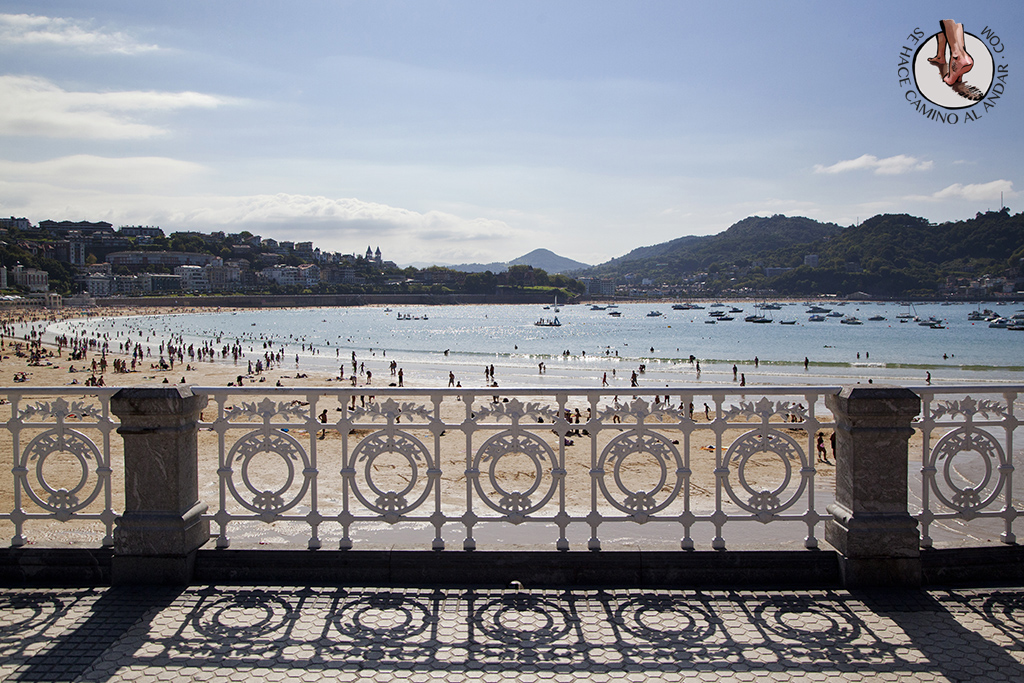You can do worse than having La Concha be the path you take to class. When I lived in Donostia, during my attempt to learn a bit of Euskara, I lived in the neighborhood Egia. While I often took the bus, when I wasn’t late and the weather was decent, I’d walk along the beach to the university – the building where our classes were held was just a few “blocks” away from the beach. Most times, I’d walk along the sidewalk above the beach, but once in a while I’d actually walk on the beach itself. It was certainly a magnificent view. As I walked along the promenade, little did I ponder the history of La Concha.

- The beach was given the name La Concha back in 1541 (in Euskara, it is called Kontxa Hondartza). The name means “the shell.” With Ondarreta beach, it connects Mount Igeldo with Mount Urgull. In the middle of the bay sits Santa Clara island. La Concha extends about 1,350 meters in length, with Ondarreta continuing on for another 600 meters. The bay sits at the mouth of the Urumea river, which starts some 33 kilometers earlier in the Nafarroan town of Goizueta.
- The beach became fashionable in the mid 1800s when Queen Isabel II, at the recommendation of her doctors, came to the city to bathe in its waters. Her doctors thought it would help her skin condition. Other royals followed.
- As the beach became popular, there were mobile cabins in which people could change in complete privacy and women wore long swim suits. However, as time passed, people became more relaxed and some even came to the beach already dressed in their bathing suits. This sparked a “war” with the cabin workers, who of course were losing income. At the same time, swimsuits became smaller, even inciting an anti-bikini editorial by El Diario Vasco in 1967.
- In 1945, the Nazi collaborator Belgian Léon Degrelle landed a small plane on the beach in his escape from the Allies during World War II.
- The Paseo de la Concha, the walkway that follows the beach, is notable for its architecture and design. There are unique lampposts which have since become a symbol of the city, their likeness used as awards for the San Sebastián Film Festival. La Perla spa, a center for thalassotherapy (the use of seawater for therapy), was established by Queen Maria Cristina and built in 1912. And the Royal Palace of Miramar, built in 1893, was the summer home of the Spanish royalty. It has a magnificent view of the bay and beach. Today, its gardens are open to the public and various buildings are used for education.
- The railing that runs along the Paseo de la Concha has become itself an iconic symbol of the city. Installed in 1910 in anticipation of the arrival of the queen, it was designed by one Juan Rafael Alday, the city architect, and was constructed by “Fundiciones Molinao.” The railing was officially inaugurated by King Alfonso XIII in 1916. Over the years, the railing deteriorated to such a state that, in 1999, the city decided to restore the iconic symbol of the city. All 271 sections were dismantled, repaired, and reinstalled.
- Since 1879 for men and 2008 for women, the Bay has played host to the Bandera de la Concha, a rowing competition held each September. The first race was won by the host city while the most recent men’s race, held just this year, was won by Santurce and the women’s 2021 race was won by a team from the host city.
Auñamendi Entziklopedia. Paseo de la Concha. Available at: https://aunamendi.eusko-ikaskuntza.eus/es/paseo-de-la-concha/ar-31981/; Historia y curiosidades de la barandilla de La Concha, Se Hace Camino Al Andar; Bahía de La Concha, Wikipedia; Kontxa, Wikipedia.
Discover more from Buber's Basque Page
Subscribe to get the latest posts sent to your email.


Greetings,
this post brought back memories!!! I remember very well the bikini war!! It started before 1967.
Shortly after WW 2, Franco was still alive, there were 2 beaches in Spain, one for the men and the other for the women. The women, of course, had the responsibility to take care of the children. Spain slowly opened to the rest of world and tourism. Because of the proximity to Spain, French tourists went to La concha–entire family. There was no European Union so tourists had to abide to Spanish laws. the family was separated–the first scandal was that French women wore 2 pieces swimsuit–not bikinis–not yet and the second scandal is that French women would let their toddlers–both sexes run around naked unsupervised–La concha beaches were relatively safe compared to the waves of the Atlantic.
Toddlers are naturally curious–it was monkey see , monkey do. The Spanish moms had to run all over the place to cover their kids bottoms.
No one was happy. So, the Spanish authorities set aside a beach for tourists at about the same time when the bikini made its appearance.
The bikini war started. The Spanish guys wanted to see the bikinis and the Spanish women, who had gained more independence, wanted to wear the bikini. Spain was and still is to some degree, in remote area, a country of los hombres en la calle y las mujeres en la casa.
Thanks for the memories!!! bikini or no bikini, I sorely miss both side of my beloved Pyrenees!!
Monique